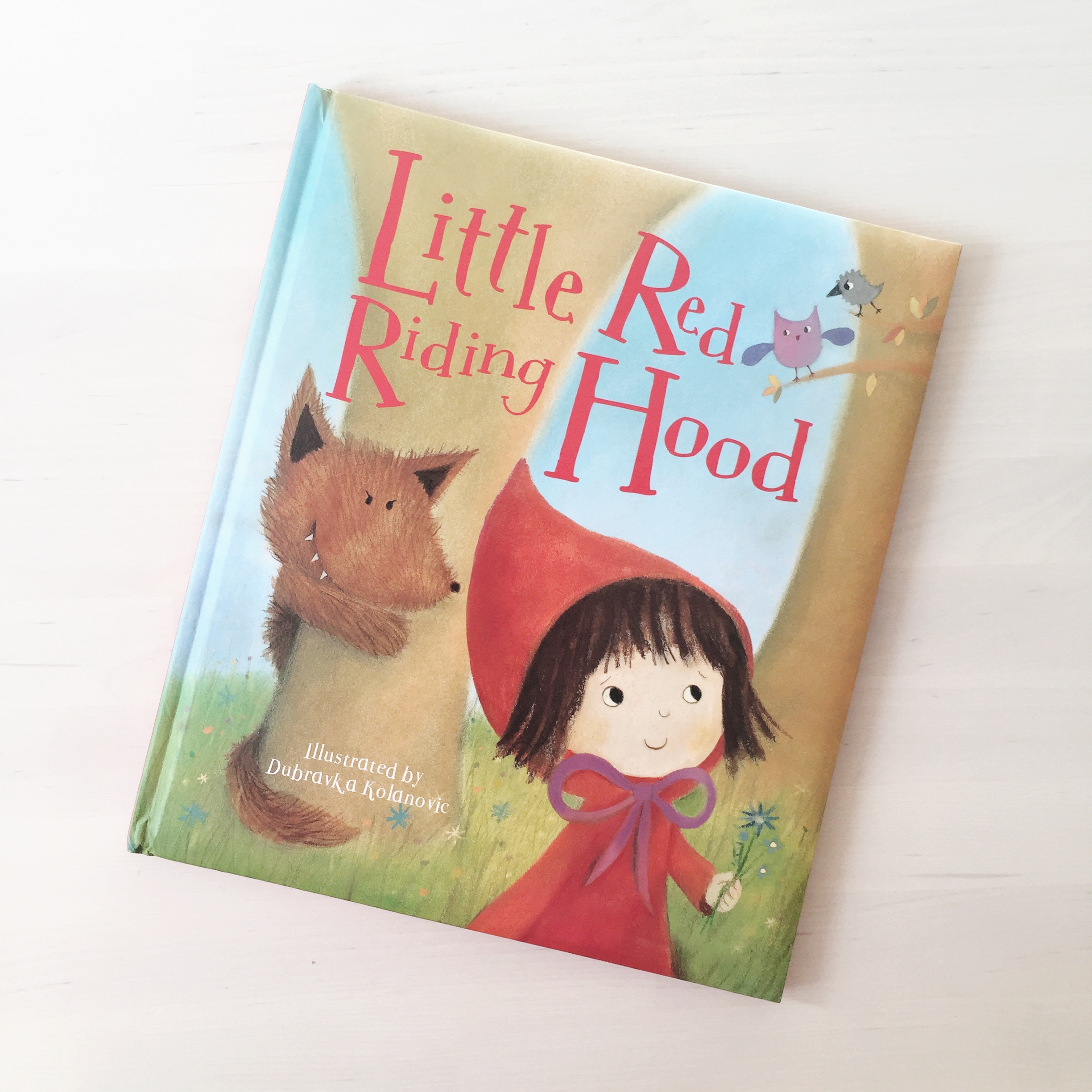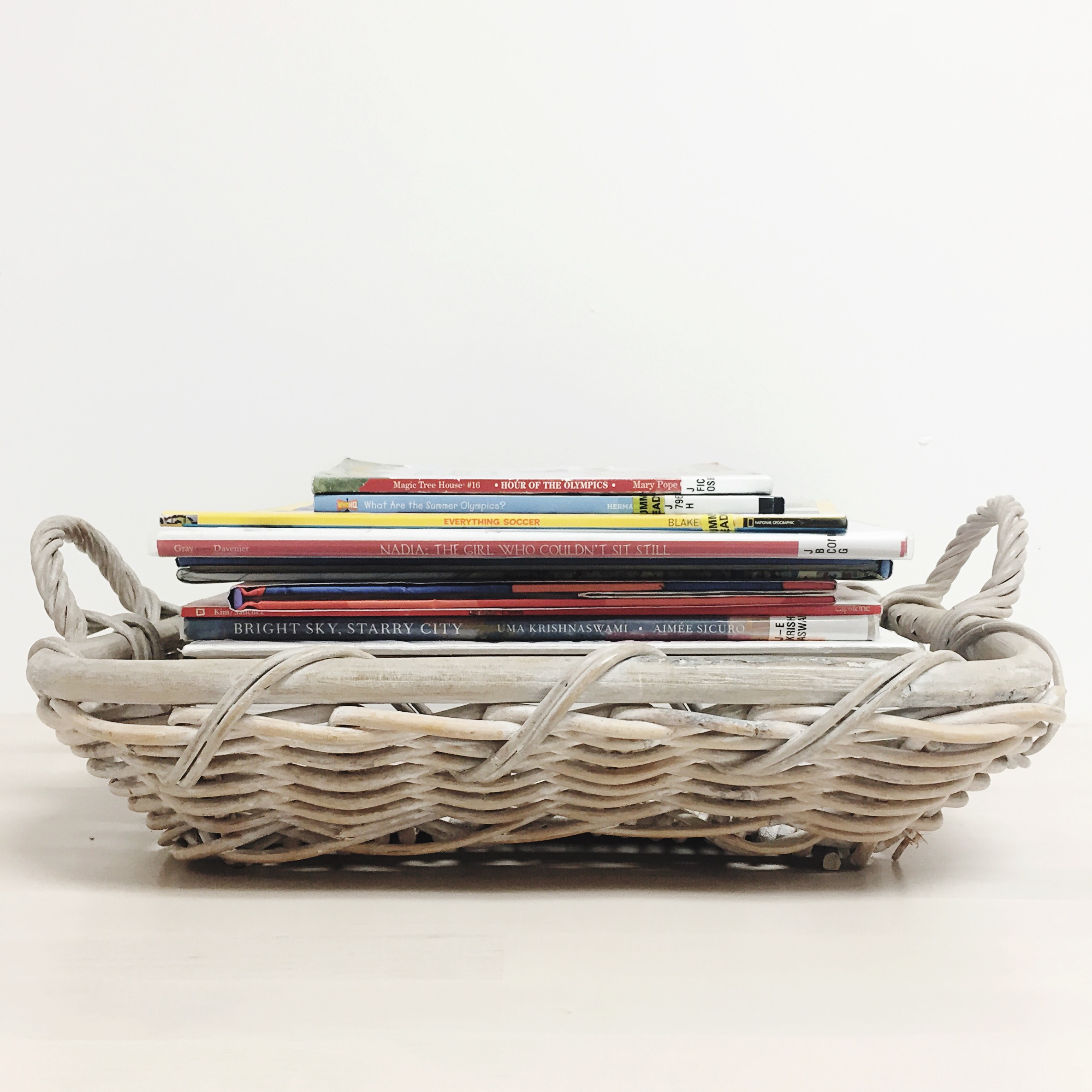You remember when Little Red went into the big woods, right? Little Red Riding Hood is a classic childhood story people know the outlines of the tale, which is what makes it a great one for a story study.
What’s a story study?
A great early literacy activity that can be used to address story structure, authors and illustrators, oral retelling, comparing and contrasting, and many other useful skills.
This post includes affiliate links.
Cool. How do I do one?
To get started, gather several copies of a Little Red Riding Hood (our list is below) and some simple Little People or Finger Puppets (here’s a cute Little Red set).
Best Versions of Little Red Riding Hood

1. Little Red Riding Hood by Dubravka Kolanovic
This is a very traditional version of little red riding hood that we own. Any simple version of the story will do, but I like the soft illustrations in this one. It is helpful to have a couple traditional versions when doing a story study. 2+
Find Online

2. Little Red Riding Hood by Mara Alperin
This is another traditional version except for the ending. We liked that the clever grandma gets away and is part of rescuing Little Red in this adaptation. 2+
Find Online

3. Little Red Riding Hood by Jerry Pinkney
Pinkney is great at putting his own subtle little marks on traditional tales. There are some small differences in the story that were fun to contrast with others and Little Red is depicted as African American in these illustrations. 3+
Find Online

4. Very Little Red Riding Hood by Teresa Heapy
This is my favorite version of Little Red Riding Hood. The main character is particularly spunky in this version. 2+
Find Online

5. Red Riding Hood and the Sweet Little Wolf by Rachael Mortimer
This is another fun alternative version wherein the wolf isn’t so big and bad, rather she is sweet and little and prefers fairy tales and pink polka dots to trapping and eating little girls. 2+
Find Online

6. Lon Po Po : A Red-Riding Hood Story from China by Ed Young
In this Chinese telling of Little Red, the mother leaves to visit grandmother (Po Po) and a wolf comes to visit the children left behind at home pretending to be their Po Po. I think it is the dark, watery illustrations that make this story seem more frightening than the more lightly illustrated American versions. It is interesting to compare and contrast. 4+
Find Online

7. Little Red Writing by Joan Holub
This wins the award for most original version of little red riding hood. A classroom of pencils are assigned the job of writing stories to share with the class and Little Red Writing decides to write an adventure. She imagines quite the tale where she ultimately encounters the Wolf 3000, a pencil sharpener, that has eaten the principal. Filled with lessons about the parts of a good story and types of words, creatively adapting the traditional tale, and illustrated by the delightful Melissa Sweet this is the perfect addition to an early elementary school classroom. 5+
Find Online

8. Little Red and the Very Hungry Lion by Alex T. Smith
This version of Little Red is laugh-out-loud funny. Instead of a wolf, it’s a bear. Instead of a sick grandma, it’s a spot covered aunt. Instead of a forest, it’s a safari. Otherwise, you know the story – you have just never heard it told quite like this.
You May Also Like:
Ultimate List of Alternative Fairy Tales

5 Activities for After You Read
1. Retell or Act Out the Story
*Use finger puppets or make your own puppets with socks or paper bags.
*Make basic costumes – If we’re acting, we usually just make headbands when we do this. Wolf ears and a red hat do the trick.
*Assign roles and take turns asking out the story. With preschoolers, I’ve found it useful to have the book handy to refer to as you go through the story the first time or two.
*Once you have done this as a group, put the puppets or costumes in your play area to encourage your kids to repeat this activity.
2. Compare & Contrast Versions
*Discuss the roles of the author and illustrator.
*Chart differences between versions of the story. Some things we kept track of include; what food Little Red has in her basket, what Little Red picks along the way, Mama’s warning to Little Red, and how the story ends.
3. Discuss Characters
The characters in a book are a crucial element of the story. Little Red Riding Hood has five traditional characters; Little Red Riding Hood, the Wolf, Mother, Grandmother, and Woodcutter.
Start by listing these characters on a piece of paper. I wrote them horizontally across the paper to leave space under each name. Then we wrote some things that we know about the character. My four year olds needed a little prompting (ex. What kind of person is __?” or “Describe how __ looks.”) but we came up with a great list of character qualities and descriptors.
4. Becoming Illustrators
Read a couple of different versions of Little Red Riding Hood and encourage them to pay attention to how the illustrator drew the characters. Have a conversation about it and compare different illustrations.
Then offer each child a piece of paper and some drawing materials to draw one of the characters. Have them pick a character and pretend they are the illustrator. They get to make all of the decisions about how that character looks. When everyone is finished, invite them to tell everyone about the character they drew.
5. Write Your Own Version
If you’re doing this story study with elementary school kids, they can work on writing versions of Little Red Riding Hood individually. The results would likely be amazing and diverse.
I have done this with preschoolers and we wrote a class version collaboratively. We started with “Once Upon a Time, there was a little ____ called Little Red Riding Hood.” My preschoolers chose what to stick in the blank space (a dinosaur in our case) and then we followed the general plot of the story.
I followed their lead as much as possible while we wrote. When I finished a sentence they dictated if they didn’t have more ideas pouring out then I’d ask an open ended question, such as “What happened next?” or “What did Little Red see in the forest?” and see where that took us.
When you reach the end, read the whole story from start to finish. I displayed our story with the illustrations they had made of different characters in our classroom. I also typed up our class version of the story and sent it home with all of the preschoolers. This was a great way to wrap up our mini-unit.
Note: this post was originally shared on my parent site Bambini Travel. It was moved here as part of my efforts to consolidate all of my literacy posts in one helpful spot!



